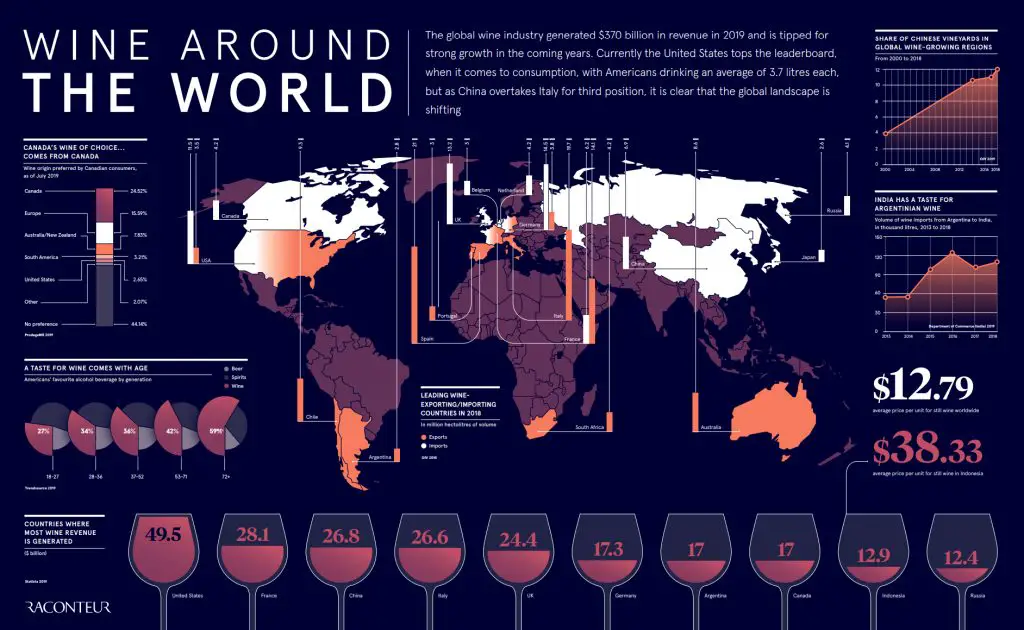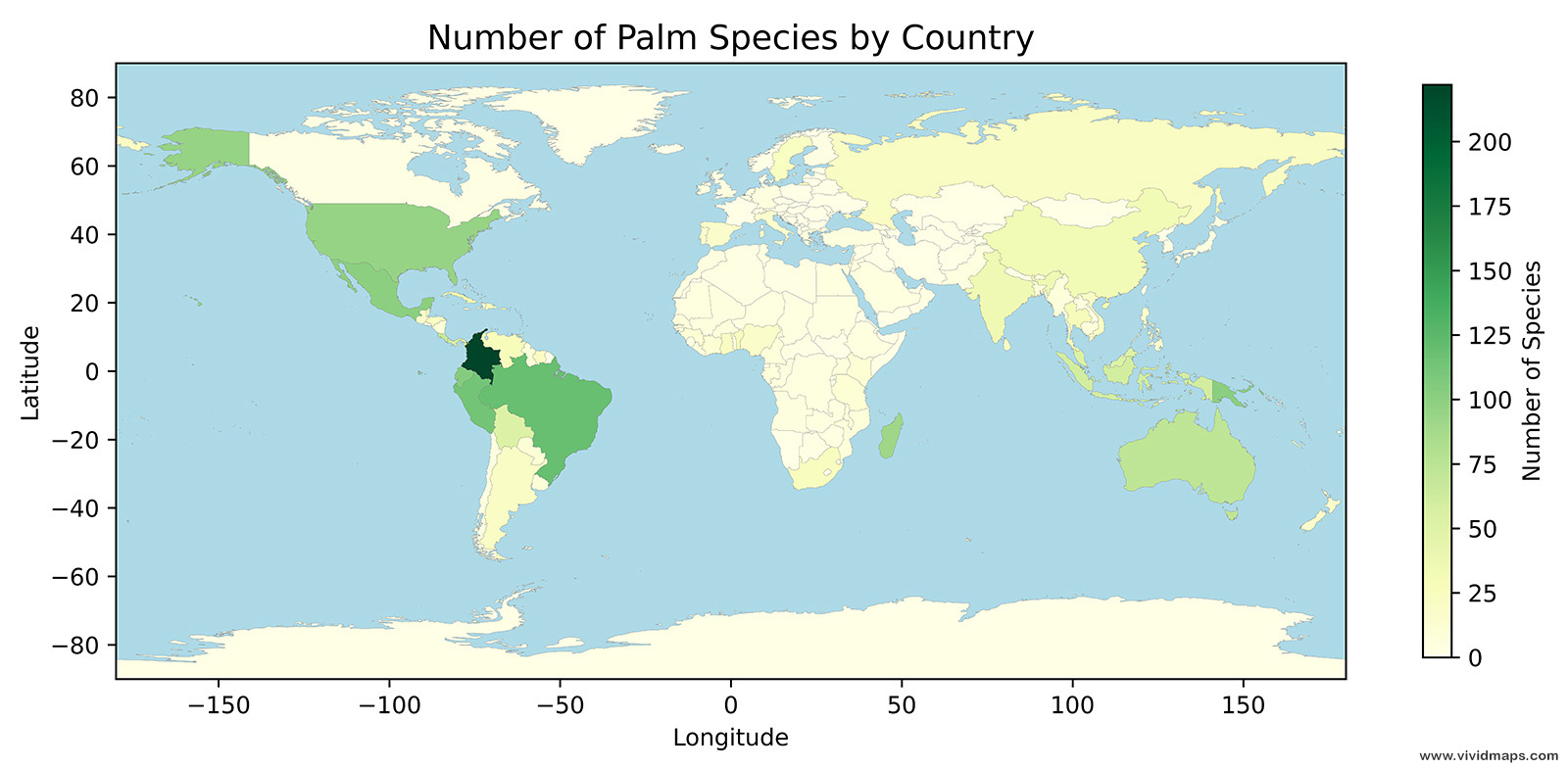Wine around the world
Nowadays, wine is the most popular alcoholic beverage drunk worldwide. Generally produced from fermented grape extract, many civilizations have created and liked wine for thousands of years. The starting of wine production can be traced back to 6 thousand years BCE from the territories where Georgia and Armenia are now located.
As viniculture methods developed through the centuries, Italy, France, Spain were amongst the most fertile wine-producing nations globally. Today, the three nations are still the advanced wine producing and exporting countries based on volume. Other large wine-producing countries globally are Argentina, Australia, Chile, Germany, South Africa, and the U.S.
In 2020, wine consumption globally amounted to 234 million hectoliters, down from 241 million hectoliters in 2019.
Table of Contents
- Top 10 nations in wine production in 2020 (million hectoliters)
- Leading wine-exporting countries (million hectoliters)
- Countries where most wine revenue is generated
- Leading wine-importing countries (million hectoliters)
- Countries that drink the most wine (million hectoliters)
- Countries that drink the most wine per capita (liters)
- Key facts about wine

Italy, France, and Spain were the top three producers of wine worldwide as of 2020.
Top 10 nations in wine production in 2020 (million hectoliters)
- Italy – 49.1
- France – 46.6
- Spain – 40.7
- United States – 22.8
- Argentina – 10.8
- Australia – 10.6
- South Africa – 10.4
- Chile – 10.3
- Germany – 8.4
- China – 6.6
Until the 1970s, international wine sales were limited, and most wines were consumed domestically. The wine business became more global in the following decades, with customers evaluating exotic, imported wines in many markets.
Nowadays, wine is produced in more than seventy countries, three of which account for almost half of the global production. European countries are the largest exporters of wine.
Leading wine-exporting countries (million hectoliters)
- Spain – 21.0
- Italy – 19.7
- France – 14.1
- Chile – 9.3
- Australia – 8.6
- South Africa – 4.2
- Germany – 3.8
- USA – 3.5
- Portugal – 3
- Argentina – 2.8
Countries where most wine revenue is generated
- United States – 49.5 billion
- France – 28.1 billion
- China – 26.8 billion
- Italy – 26.6 billion
- United Kingdom – 24.4 billion
- Germany – 17.3 billion
- Argentina – 17 billion
- Canada – 17 billion
- Indonesia – 12.9 billion
- Russia – 12.4 billion
Leading wine-importing countries (million hectoliters)
- Germany – 14.5
- United Kingdom – 13.2
- United States – 11.5
- Australia – 8.6
- China – 6.9
- France – 6.2
- Canada – 4.2
- Netherland – 4.2
- Russia – 4.1
- Belgium – 3
- Japan – 2.6
According to the International Organisation of Vine and Wine, The United States leads on wine consumption (33 million hectoliters or 3.7 liters per person per year), making about $50 billion in income. Older persons of Americans prefer wine to other alcoholic drinks. Spirits are the favorite drink for aged 18 to 27. Only 27 percent of this age group prefers wine to spirits or beer.
In the United States, most wine drunk is manufactured domestically. California is the nation’s top-producing state.
Countries that drink the most wine (million hectoliters)
- United States – 33
- France – 24.7
- Italy – 24.5
- Germany – 19.8
- United Kingdom – 13.3
- China – 12.4
- Russia – 10.3
- Spain – 9.6
- Argentina – 9.4
- Australia – 5.7
European nations dominate the per-person consumption list.
Countries that drink the most wine per capita (liters)
- Portugal – 48.5
- France – 39.0
- Italy – 36.3
- Switzerland – 32.2
- Austria – 26.1
- Hungary – 25.7
- Germany – 25.4
- Australia – 23.1
- Belgium – 23.1
- Sweden – 22.7
Key facts about wine
- There are approximately 1,400 varieties of grape that are practiced to create wine.
- Because of the complex organic compounds, wine is considered more complicated than blood serum.
- To get the equivalent quantity of antioxidants you find in wine, you must drink twenty glasses of apple juice or seven glasses of orange juice.
- Red wine is good for health. It decreases your probability of having a stroke as opposed to nondrinkers. For people who consume wine moderately, it reduces their risk of progressing two-type diabetes by 30 percent.
- Believe it or not, some people have a phobia of wine. It’s called “oenophobia.”
- Ben Franklin was cited, “Wine makes daily life easy, less hurried, with fewer tension and more tolerance.”
- How do you take a wine glass? Wine glasses should be taken by the stem so that your hand doesn’t increase the temperature of the wine.
- Why do you keep wine lying down? The cork could dehydrate and diminishes if the bottle is standing up, maybe falling into the wine bottle.
- Women are more likely to influences by wine than men. It is because they have fewer enzymes in the stomach lining required to split down alcohol molecules.
- The oldest acknowledged wine cellar is on the Titanic. Surprisingly, when scuba divers went down to the wreck, most of the bottles of wine were still intact.
- The oldest bottle of wine in the world was discovered near the town of Speyer in Germany. It dates before AD 325.
- When matching wine with meals, the heavier food goes appropriately with heavier and richer wines. Commonly, red wine is consumed with red meat. The lighter meals are appropriate with the light wines. White wine goes perfectly with fish and chicken. If you are searching for wine for dessert, go for sweet wine.
- California is the fourth-largest manufacturer of wine worldwide. The another three are Spain, Italy, France.
- The Phoenicians distributed wine around the Mediterranean in the 10th century BCE, introducing it to the ancient Greeks, who encouraged the Romans to become wine enthusiasts and plant grapes across the large territory of the Roman empire.
- One bottle of wine (75cl) holds the juice of 600-800 grapes.
- Ten nations consume 70 percent of volumes produced globally.
- The top 3 export markets are the U.S., the U.K., and China. They estimate 50 percent of global revenue.
- There is a large gap between wine production and consumption. There is more wine produced than consumed. It is an ordinary situation because some of the produced wine is distilled to make spirits, and some are changed into vinegar.
Want to learn more about wine? Then have a look at the following world atlas:









China will come